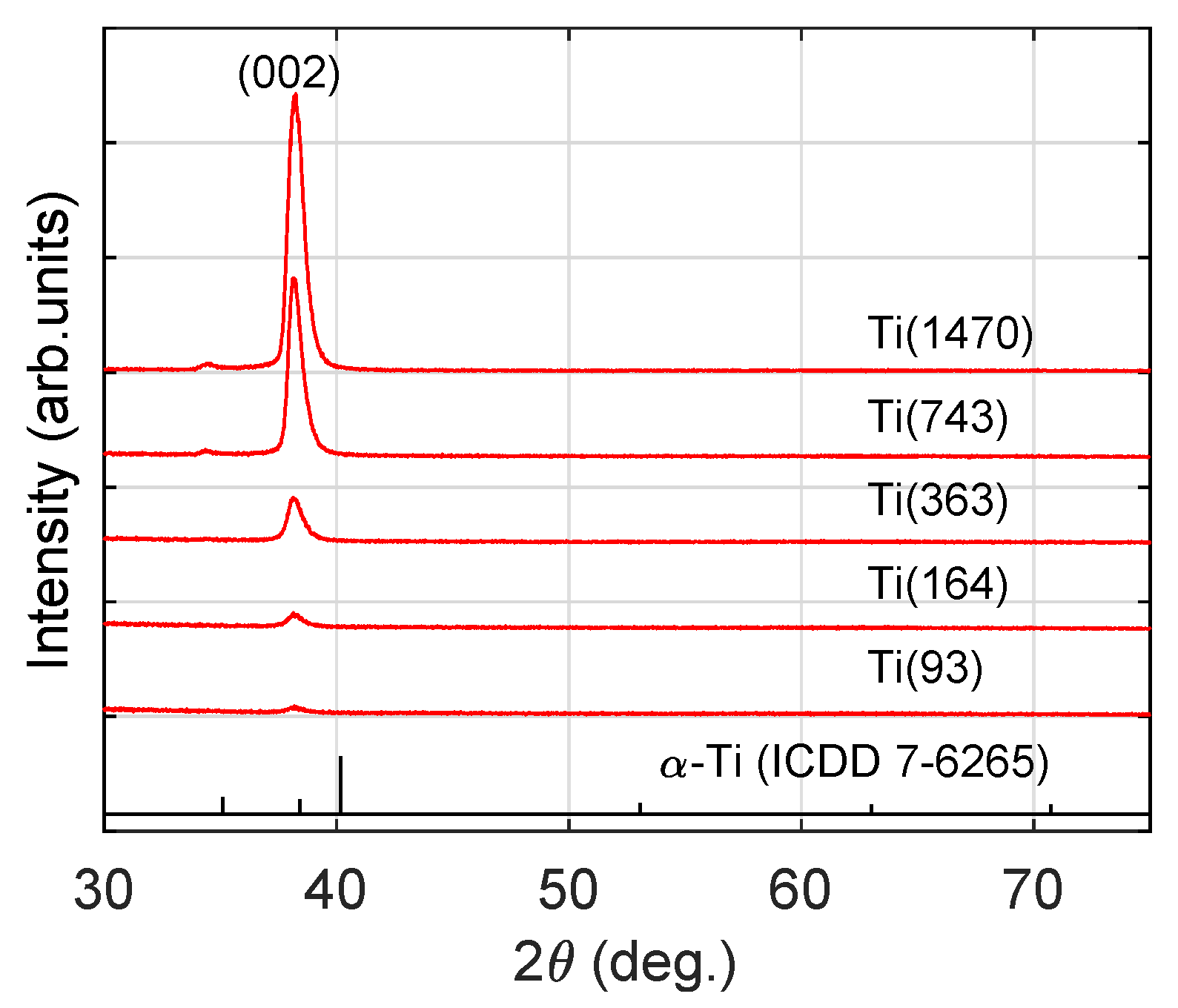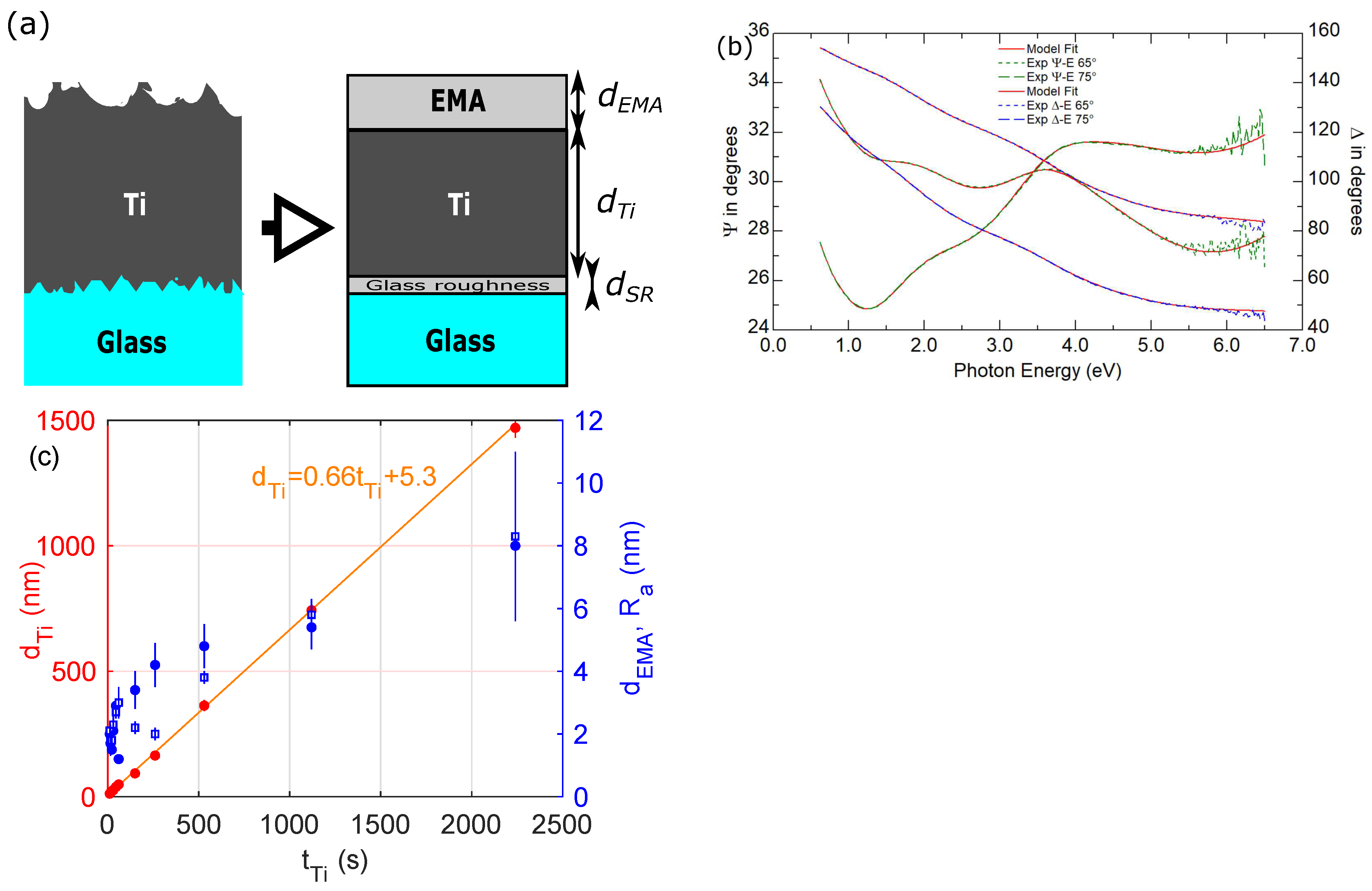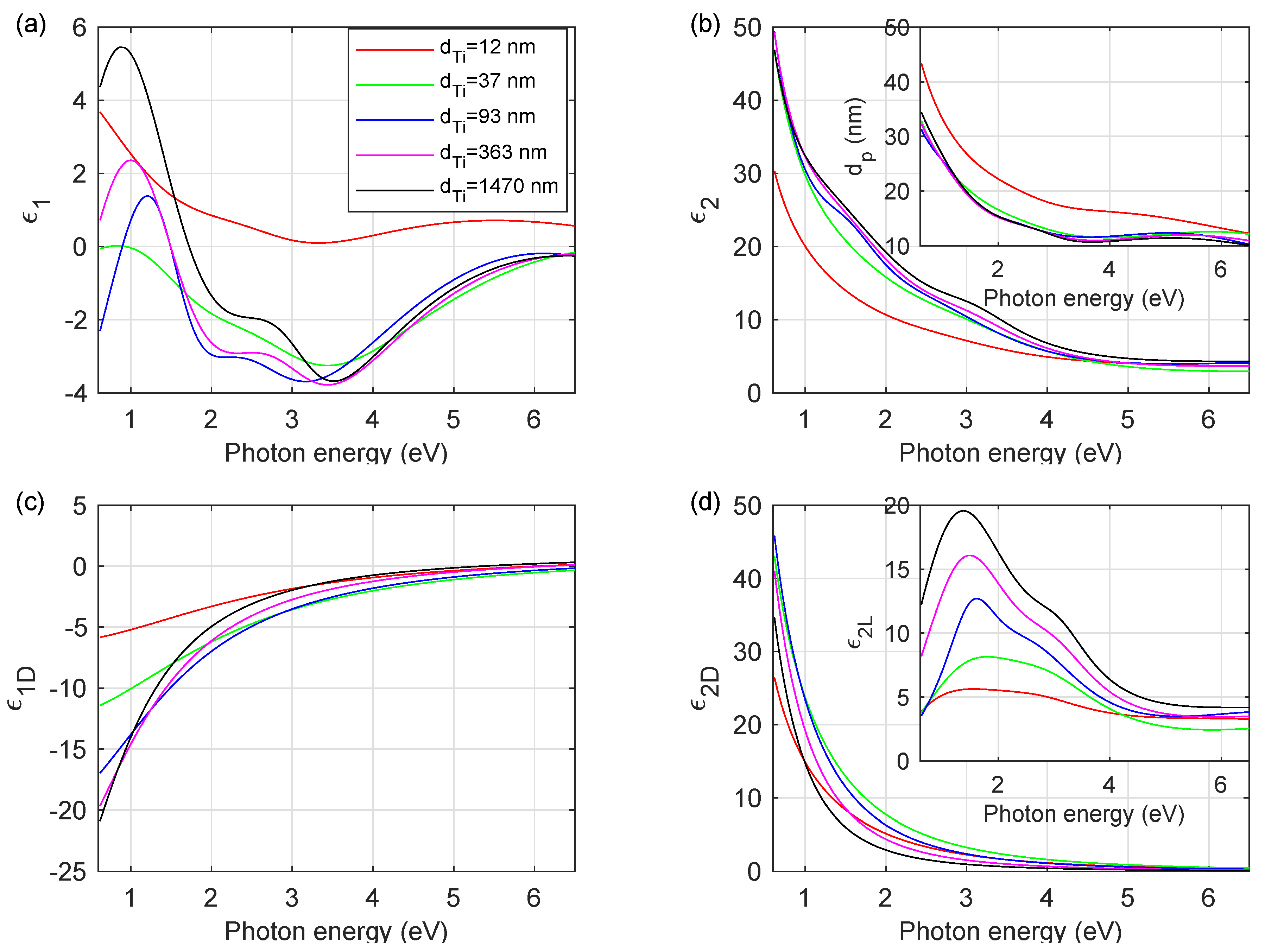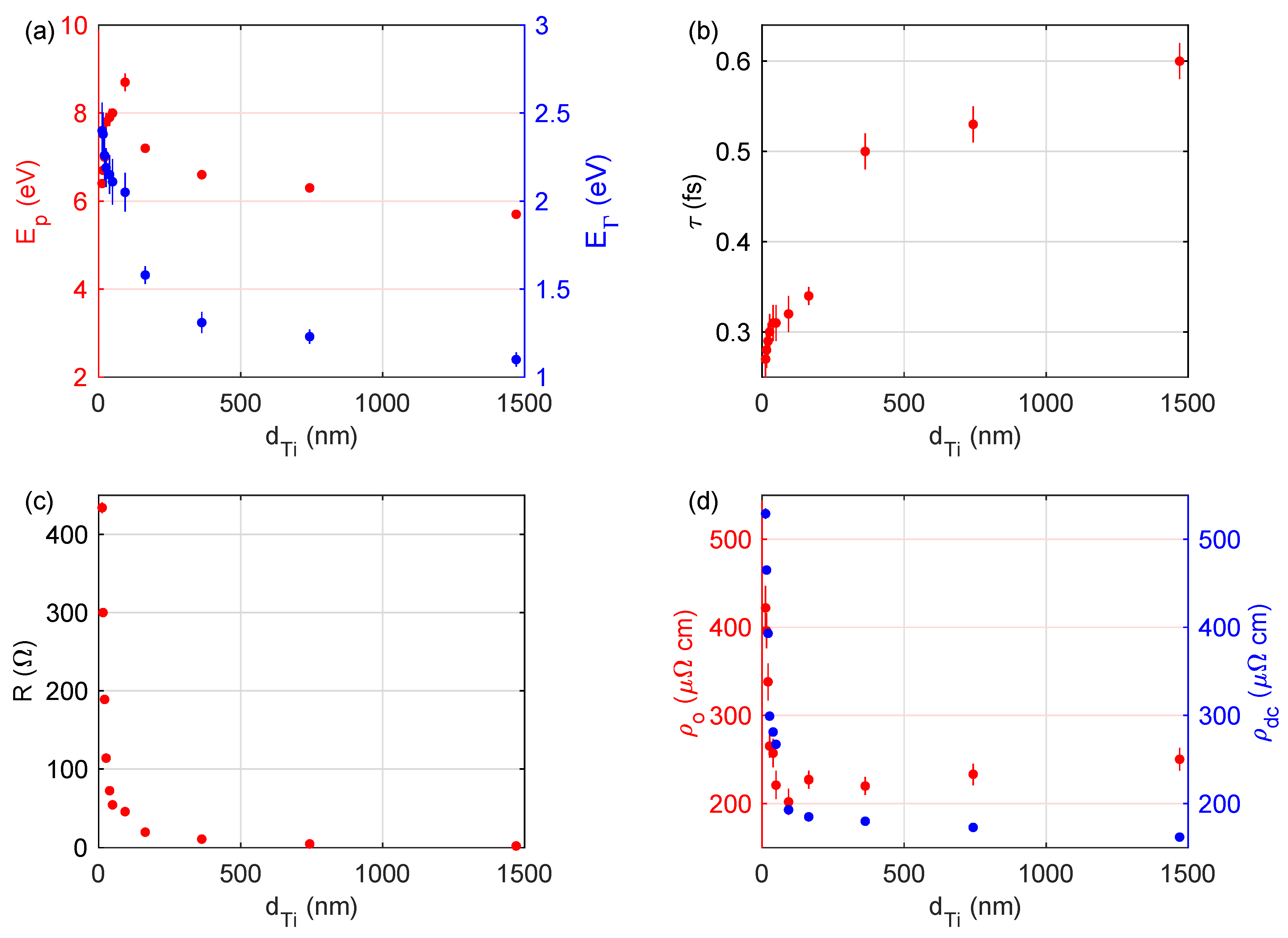Optical Properties of Titanium in the Regime of the Limited Light Penetration
Abstract
1. Introduction
2. Materials and Methods
2.1. Sample Preparation
2.2. Sample Characterization
3. Results and Discussion
3.1. Topography of Ti Coatings
3.2. XRD Measurements
3.3. Optical and Electrical Properties of the Titanium Films
4. Conclusions
Funding
Acknowledgments
Conflicts of Interest
References
- Thornton, J.A. Influence of apparatus geometry and deposition conditions on the structure and topography of thick sputtered coatings. J. Vac. Sci. Technol. 1974, 11, 666–670. [Google Scholar] [CrossRef]
- Chawla, V.; Jayaganthan, R.; Chawla, A.K.; Chandra, R. Morphological study of magnetron sputtered Ti thin films on silicon substrate. Mater. Chem. Phys. 2008, 111, 414–418. [Google Scholar] [CrossRef]
- Chawla, V.; Jayaganthan, R.; Chawla, A.K.; Chandra, R. Microstructural characterizations of magnetron sputtered Ti films on glass substrate. J. Mater. Process. Technol. 2009, 209, 3444–3451. [Google Scholar] [CrossRef]
- Zhang, L.; Shia, L.Q.; He, Z.J.; Zhang, B.; Lu, Y.F.; Liu, A.; Wang, B.Y. Deposition of dense and smooth Ti films using ECR plasma-assisted magnetron sputtering. Surf. Coat. Technol. 2009, 203, 3356–3360. [Google Scholar] [CrossRef]
- Jin, Y.; Wu, W.; Li, L.; Chen, J.; Zhang, J.; Zuo, Y.; Fu, J. Effect of sputtering power on surface topography of dc magnetron sputtered Ti thin films observed by AFM. Appl. Surf. Sci. 2009, 255, 4673–4679. [Google Scholar] [CrossRef]
- Jung, M.J.; Nam, K.H.; Shaginyan, L.R.; Han, J.G. Deposition of Ti thin film using the magnetron sputtering method. Thin Solid Films 2003, 435, 145–149. [Google Scholar] [CrossRef]
- Martin, N.; Baretti, D.; Rousselot, C.; Rauch, J.Y. The effect of bias power on some properties of titanium and titanium oxide films prepared by r.f. magnetron sputtering. Surf. Coat. Technol. 1998, 107, 172–182. [Google Scholar] [CrossRef]
- Šícha, J.; Musil, J.; Meissner, M.; Čerstvý, R. Nanostructure of photocatalytic TiO2 films sputtered at temperatures below 200 ∘C. Appl. Surf. Sci. 2008, 254, 3793–3800. [Google Scholar] [CrossRef]
- Zdunek, K.; Nowakowska-Langier, K.; Dora, J.; Chodun, R. Gas injection as a tool for plasma process control during coating deposition. Surf. Coat. Technol. 2013, 228, S367–S373. [Google Scholar] [CrossRef]
- Zdunek, K.; Nowakowska-Langier, K.; Chodun, R.; Okrasa, S.; Rabiński, M.; Dora, J.; Domanowski, P.; Halarewicz, J. Impulse Plasma In Surface Engineering-a review. J. Phys. Conf. Ser. 2014, 564, 012007. [Google Scholar] [CrossRef]
- Zdunek, K.; Skowronski, L.; Chodun, R.; Nowakowska-Langier, K.; Grabowski, A.; Wachowiak, W.; Okrasa, S.; Wachowiak, A.A.; Strauss, O. Nowel GIMS technique for deposition of colored Ti/TiO2 coatings in industrial scale. MSP 2016, 34, 137–141. [Google Scholar]
- Skowroński, Ł.; Trzcinski, M.; Antończak, A.J.; Domanowski, P.; Kustra, M.; Wachowiak, W.; Naparty, M.K.; Hiller, T.; Bukaluk, A.; Wronkowska, A.A. Characterisation of coloured TiOx/Ti/glass systems. Appl. Surf. Sci. 2014, 322, 209–214. [Google Scholar]
- Skowronski, L.; Wachowiak, A.A.; Grabowski, A. Characterization of optical and microstructural properties of semitransparent TiO2/Ti/glass interference decorative coatings. Appl. Surf. Sci. 2016, 388, 731–740. [Google Scholar] [CrossRef]
- Skowronski, L.; Wachowiak, A.A.; Wachowiak, W. Optical and microstructural properties of decorative Al/Ti/TiO2 interference coatings. Appl. Surf. Sci. 2017, 421, 794–801. [Google Scholar] [CrossRef]
- Skowronski, L.; Wachowiak, A.A.; Zdunek, K.; Trzcinski, M.; Naparty, M.K. TiO2-based decorative coatings deposited on the AISI 316L stainless steel and glass using an industrial scale magnetron. Thin Solid Films 2017, 627, 1–8. [Google Scholar] [CrossRef]
- Chodun, R.; Skowronski, L.; Okrasa, S.; Wicher, B.; Nowakowska-Langier, K.; Zdunek, K. Optical TiO2 layers deposited on polymer substrates by the Gas Injection Magnetron Sputtering technique. Appl. Surf. Sci. 2019, 466, 12–18. [Google Scholar] [CrossRef]
- Skowronski, L.; Zdunek, K.; Nowakowska-Langier, K.; Chodun, R.; Trzcinski, M.; Kobierski, M.; Kustra, M.K.; Wachowiak, A.A.; Wachowiak, W.; Hiller, T.; et al. Characterization of microstructural, mechanical and optical properties of TiO2 layers deposited by GIMS and PMS methods. Surf. Coat. Technol. 2015, 282, 16–23. [Google Scholar] [CrossRef]
- Henderson, P.S.; Kelly, P.J.; Arnell, R.D.; Bäcker, H.; Bradley, J.W. Investigation into the properties of titanium based films deposited using pulsed magnetron sputtering. Surf. Coat. Technol. 2003, 174–175, 779–783. [Google Scholar] [CrossRef]
- Hofmann, K.; Spangenberg, B.; Luysberg, M.; Kurz, H. Properties of evaporated titanium thin films and their possible application in single electron devices. Thin Solid Films 2003, 436, 168–174. [Google Scholar] [CrossRef]
- Jeyachandran, Y.L.; Karunagaran, B.; Narayandass, S.K.; Mangalaraj, D. The effect of thickness on the properties of titanium films deposited by dc magnetron sputtering. Mater. Sci. Eng. A 2007, 458, 361–365. [Google Scholar] [CrossRef]
- Jeyachandran, Y.L.; Karunagaran, B.; Narayandass, S.K.; Mangalaraj, D.; Jenkins, T.E.; Martin, P.J. Properties of titanium thin films deposited by dc magnetron sputtering. Mater. Sci. Eng. A 2006, 431, 277–284. [Google Scholar] [CrossRef]
- Rakić, A.D.; Djurišić, A.B.; Elazar, J.M.; Majewski, M.L. Optical properties of metallic films for vertical-cavity optoelectronic devices. Appl. Opt. 1998, 37, 5271–5283. [Google Scholar] [CrossRef] [PubMed]
- Mahmoud, S. Structure and optical properties of thin titanium films deposited on different substrates. J. Mater. Sci. 1987, 22, 3693–3697. [Google Scholar] [CrossRef]
- Johnson, P.B.; Christy, R.W. Optical constants of transition metals: Ti, V, Cr, Mn, Fe, Co, Ni, and Pd. Phys. Rev. B 1974, 9, 5056–5070. [Google Scholar] [CrossRef]
- Domanowski, P.; Wawrzak, A. Automation of thin film deposition process based on magnetron sputtering. J. Mach. Eng. 2012, 2, 111–119. [Google Scholar]
- Posadowski, W.M.; Wiatrowski, A.; Dora, J.; Radzimski, Z.J. Magnetron sputtering process control by medium-frequency power supply parameter. Thin Solid Films 2008, 516, 4478–4482. [Google Scholar] [CrossRef]
- Wicher, B.; Chodun, R.; Nowakowska-Langier, K.; Trzcinski, M.; Skowronski, L.; Okrasa, S.; Minikayev, R.; Naparty, M.K.; Zdunek, K. Chemical and structural characterization of tungsten nitride (WNx) thin films synthesized via Gas Injection Magnetron Sputtering technique. Vacuum 2019, 165, 266–273. [Google Scholar] [CrossRef]
- Strzelecki, G.W.; Nowakowska-Langier, K.; Chodun, R.; Okrasa, S.; Wicher, B.; Zdunek, K. Influence of modulation frequency on the synthesis of thin films in pulsed magnetron sputtering processes. MSP 2018, 36, 697–703. [Google Scholar] [CrossRef]
- Wicher, B.; Chodun, R.; Kwiatkowski, R.; Trzcinski, M.; Nowakowska–Langier, K.; Lachowski, A.; Minikayev, R.; Rudnicki, J.; Naparty, M.K.; Zdunek, K. Plasmochemical investigations of DLC/WCx nanocomposite coatings synthesized by gas injection magnetron sputtering technique. Diam. Relat. Mater. 2019, 96, 1–10. [Google Scholar] [CrossRef]
- Yakubowski, D.I.; Arsenin, A.V.; Stebunov, Y.V.; Fedyanin, D.Y.; Volkov, V.S. Optical constants and structural properties of thin gold films. Opt. Express 2017, 25, 25574–25587. [Google Scholar]
- Fujiwara, H. Spectroscopic Ellipsometry. Principles and Applications; John Wiley & Sons Ltd.: Chichester, UK, 2009. [Google Scholar]
- Woollam, J.A. Guide to Using WVASE32®; Wextech Systems Inc.: New York, NY, USA, 2010. [Google Scholar]
- Rerek, T.; Skowronski, L.; Szczesny, R.; Naparty, M.K.; Derkowska-Zielinska, B. The effect of the deposition rate on microstructural and opto-electronic properties of β-Sn layers. Thin Solid Films 2019, 670, 86–92. [Google Scholar] [CrossRef]
- Rerek, T.; Skowronski, L.; Kobierski, M.; Naparty, M.K.; Derkowska-Zielinska, B. Microstructure and opto-electronic properties of Sn-rich Au-Sn diffusive solders. Appl. Surf. Sci. 2018, 451, 32–39. [Google Scholar] [CrossRef]
- Wronkowska, A.A.; Czerniak, G.; Wronkowski, A.; Skowronski, L. Optical and microstructural characterisation of Au–Sn and Cu–Sn diffusive layers. Appl. Surf. Sci. 2013, 281, 30–37. [Google Scholar] [CrossRef]
- Wakagi, M.; Fujiwara, H.; Collins, R.W. Real time spectroscopic ellipsometry for characterization of the crystallization of amorphous silicon by thermal annealing. Thin Solid Films 1998, 313-314, 464–468. [Google Scholar] [CrossRef]





| Sample | (eV) | (eV) | (fs) | ( cm) | ( cm) | R() |
|---|---|---|---|---|---|---|
| Ti(12) * | 6.4 ± 0.1 | 2.40 ± 0.16 | 0.27 ± 0.02 | 422 ± 25 | 529 ± 6 | 434 ± 7 |
| Ti(16) * | 6.7 ± 0.1 | 2.38 ± 0.12 | 0.28 ± 0.02 | 396 ± 20 | 465 ± 5 | 300 ± 5 |
| Ti(21) * | 7.0 ± 0.1 | 2.26 ± 0.14 | 0.29 ± 0.02 | 338 ± 21 | 393 ± 4 | 189 ± 3 |
| Ti(26) * | 7.8 ± 0.2 | 2.19 ± 0.11 | 0.30 ± 0.02 | 265 ± 13 | 299 ± 3 | 114 ± 2 |
| Ti(37) * | 7.9 ± 0.2 | 2.15 ± 0.11 | 0.31 ± 0.02 | 257 ± 16 | 281 ± 1 | 72.8 ± 0.6 |
| Ti(49) * | 8.0 ± 0.1 | 2.11 ± 0.13 | 0.31 ± 0.02 | 221 ± 16 | 267 ± 1 | 54.7 ± 0.5 |
| Ti(93) | 8.7 ± 0.2 | 2.05 ± 0.11 | 0.32 ± 0.02 | 202 ± 15 | 193 ± 1 | 46.0 ± 0.1 |
| Ti(164) | 7.2 ± 0.1 | 1.58 ± 0.05 | 0.42 ± 0.01 | 227 ± 10 | 185 ± 1 | 19.8 ± 0.2 |
| Ti(363) | 6.6 ± 0.1 | 1.31 ± 0.06 | 0.50 ± 0.02 | 220 ± 10 | 180 ± 1 | 10.9 ± 0.2 |
| Ti(743) | 6.3 ± 0.1 | 1.23 ± 0.04 | 0.53 ± 0.02 | 233 ± 12 | 173 ± 1 | 4.76 ± 0.06 |
| Ti(1470) | 5.7 ± 0.1 | 1.10 ± 0.04 | 0.60 ± 0.02 | 250 ± 13 | 162 ± 1 | 2.18 ± 0.04 |
| Sample | (s) | (nm) | (nm) | (nm) | (nm) |
|---|---|---|---|---|---|
| Ti(12) * | 11 | 12.2 ± 0.1 | 2.0 ± 0.1 | 2.1 ± 0.2 | - |
| Ti(16) * | 15 | 15.5 ± 0.2 | 1.7 ± 0.1 | 1.8 ± 0.5 | - |
| Ti(21) * | 22 | 20.8 ± 0.3 | 1.5 ± 0.1 | 1.8 ± 0.3 | - |
| Ti(26) * | 30 | 26.2 ± 0.1 | 2.1 ± 0.1 | 2.3 ± 0.3 | - |
| Ti(37) * | 45 | 38.6 ± 0.1 | 2.9 ± 0.1 | 2.7 ± 0.2 | - |
| Ti(49) * | 60 | 48.8 ± 0.2 | 1.2 ± 0.1 | 3.0 ± 0.5 | - |
| Ti(93) | 150 | 93 ± 7 | 3.4 ± 0.6 | 2.2 ± 0.2 | 8 ± 5 |
| Ti(164) | 260 | 164 ± 10 | 4.2 ± 0.7 | 2.0 ± 0.2 | 10 ± 4 |
| Ti(363) | 530 | 363 ± 22 | 4.8 ± 0.7 | 3.8 ± 0.2 | 7 ± 3 |
| Ti(743) | 1120 | 743 ± 11 | 5.4 ± 0.7 | 5.8 ± 0.5 | 7 ± 3 |
| Ti(1470) | 2240 | 1470 ± 40 | 8.0 ± 1.4 | 8.3 ± 2.7 | 7 ± 3 |
© 2020 by the author. Licensee MDPI, Basel, Switzerland. This article is an open access article distributed under the terms and conditions of the Creative Commons Attribution (CC BY) license (http://creativecommons.org/licenses/by/4.0/).
Share and Cite
Skowronski, L. Optical Properties of Titanium in the Regime of the Limited Light Penetration. Materials 2020, 13, 952. https://doi.org/10.3390/ma13040952
Skowronski L. Optical Properties of Titanium in the Regime of the Limited Light Penetration. Materials. 2020; 13(4):952. https://doi.org/10.3390/ma13040952
Chicago/Turabian StyleSkowronski, Lukasz. 2020. "Optical Properties of Titanium in the Regime of the Limited Light Penetration" Materials 13, no. 4: 952. https://doi.org/10.3390/ma13040952
APA StyleSkowronski, L. (2020). Optical Properties of Titanium in the Regime of the Limited Light Penetration. Materials, 13(4), 952. https://doi.org/10.3390/ma13040952





